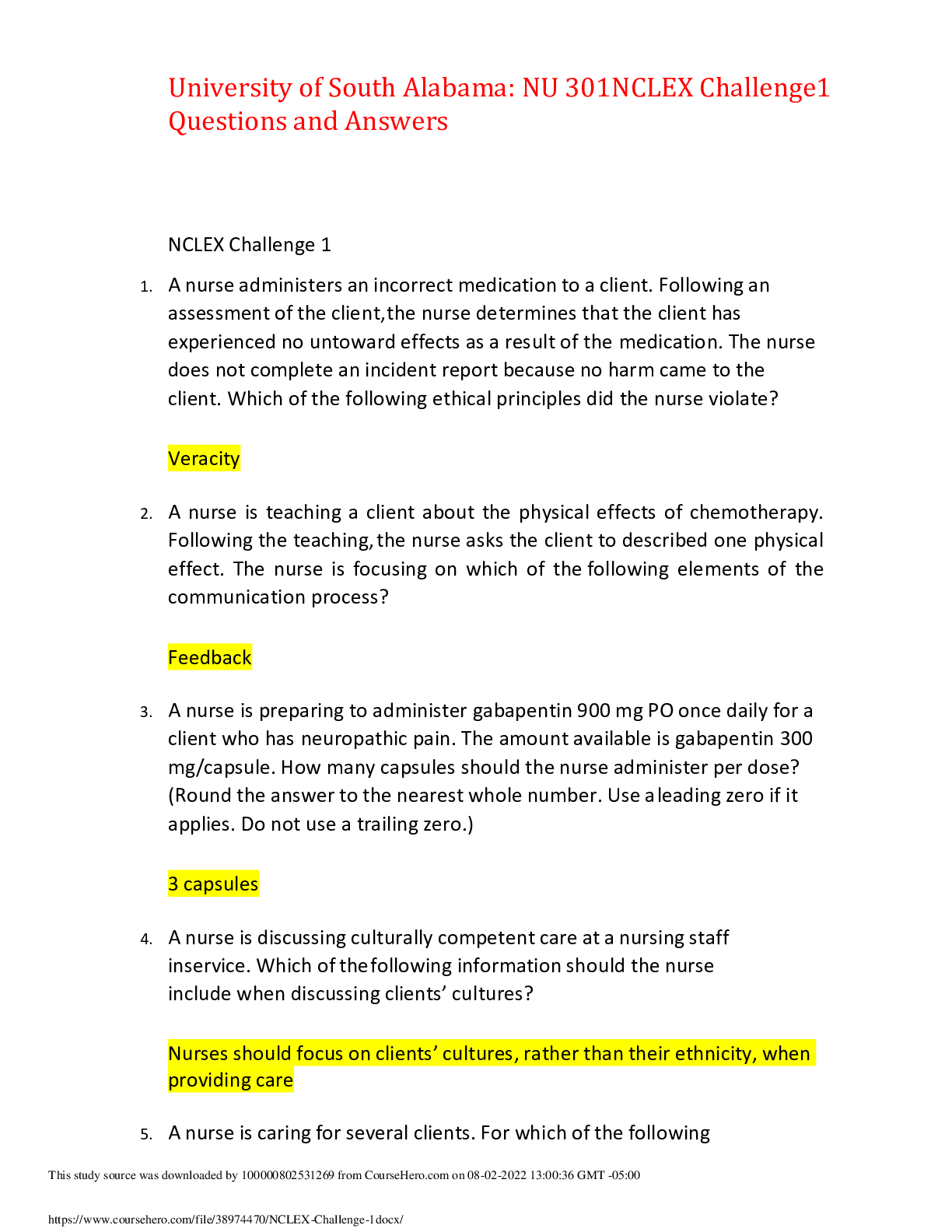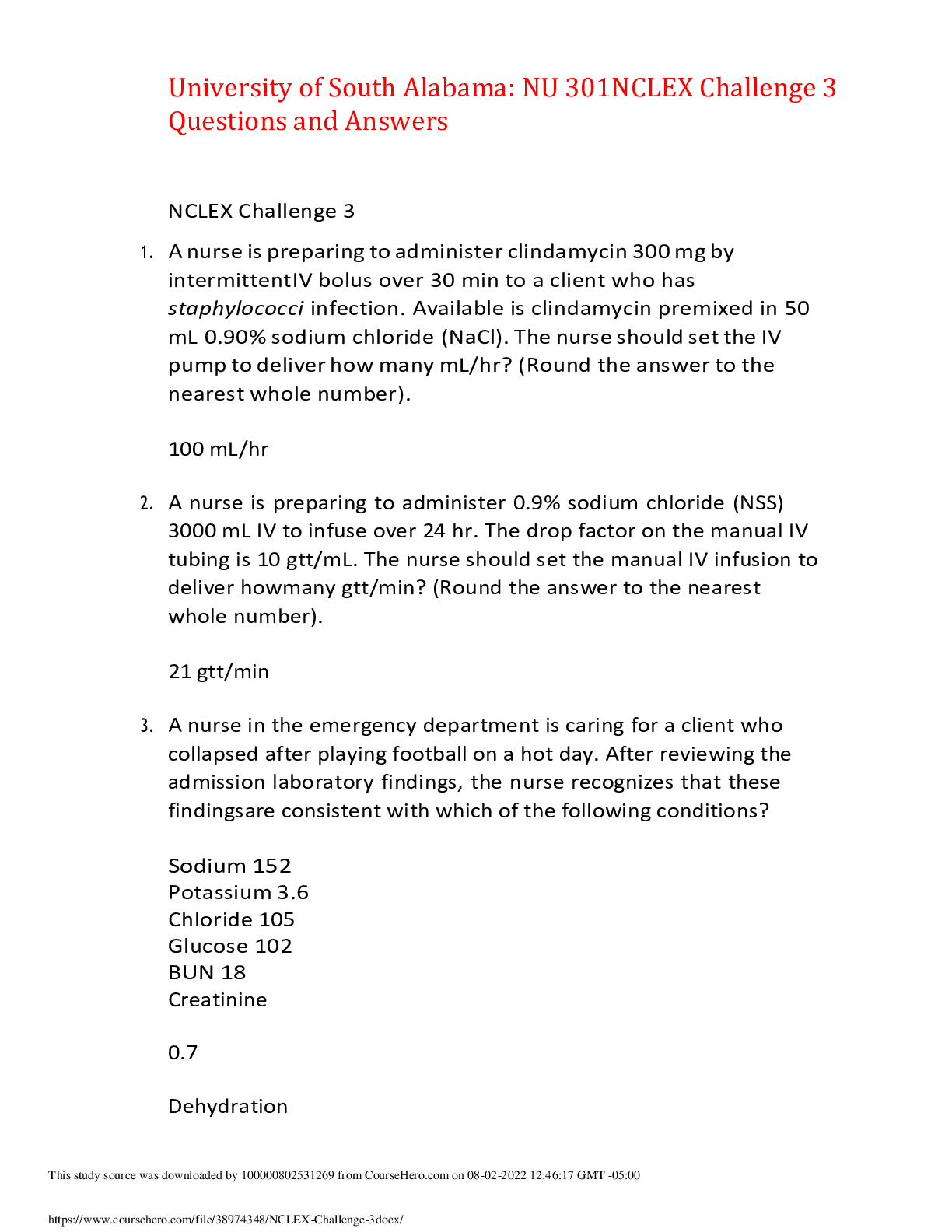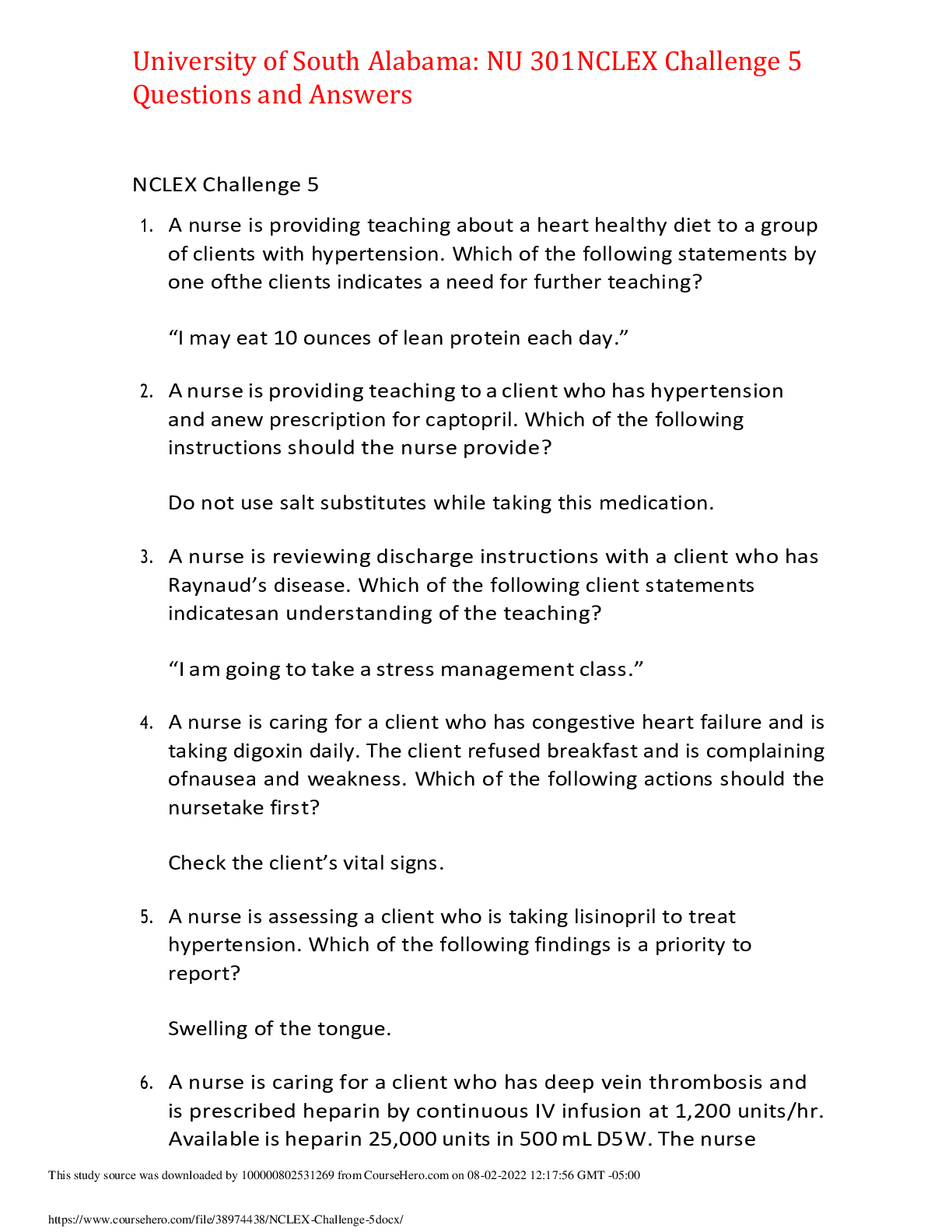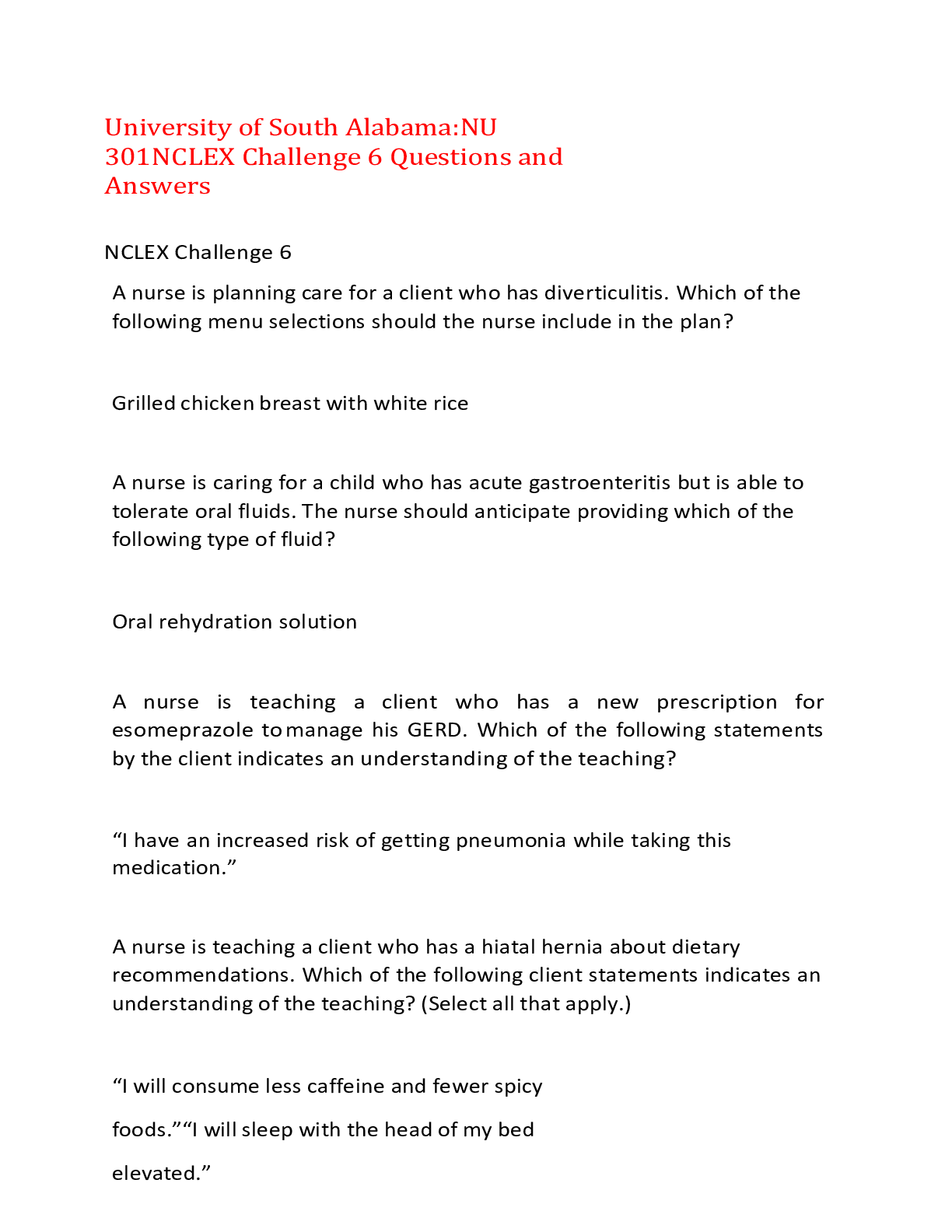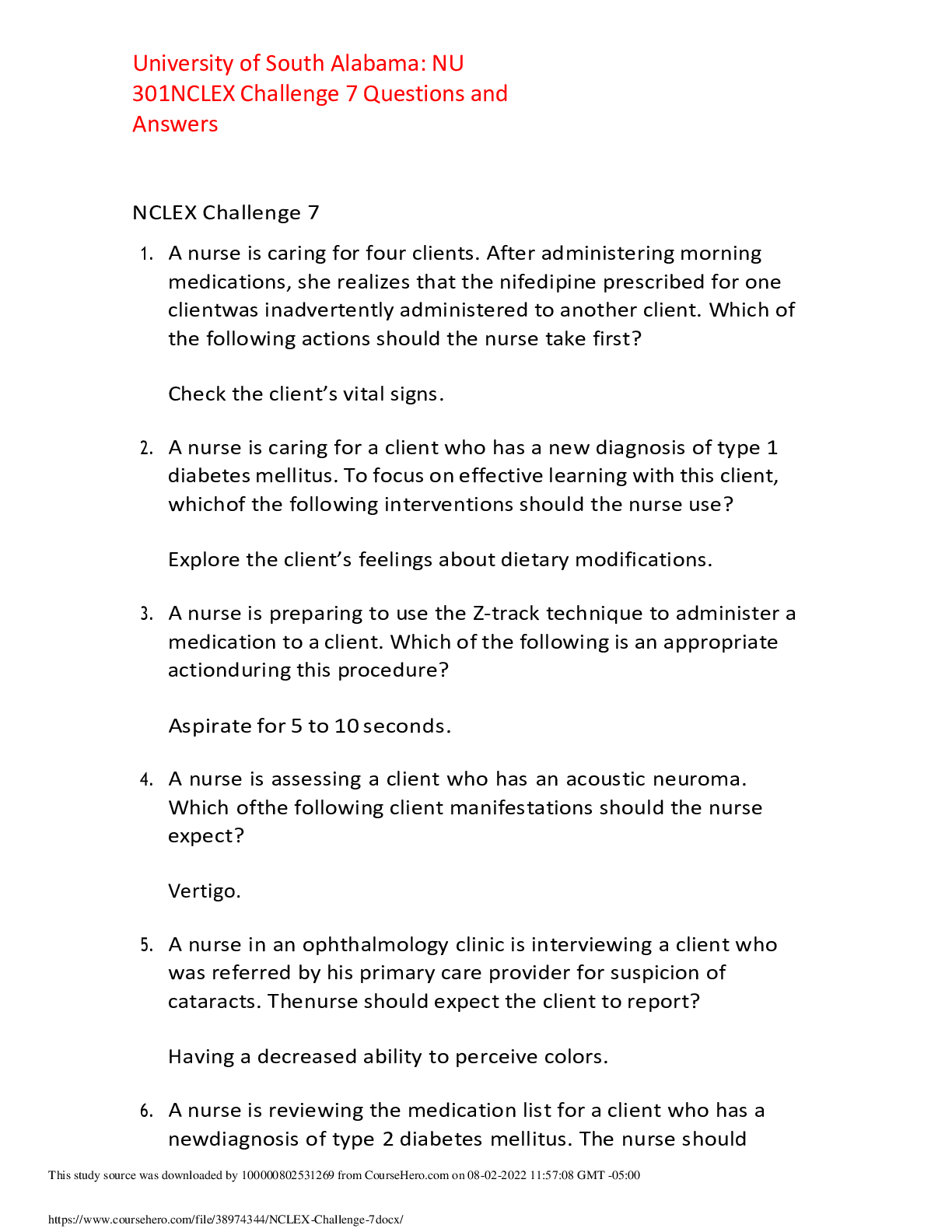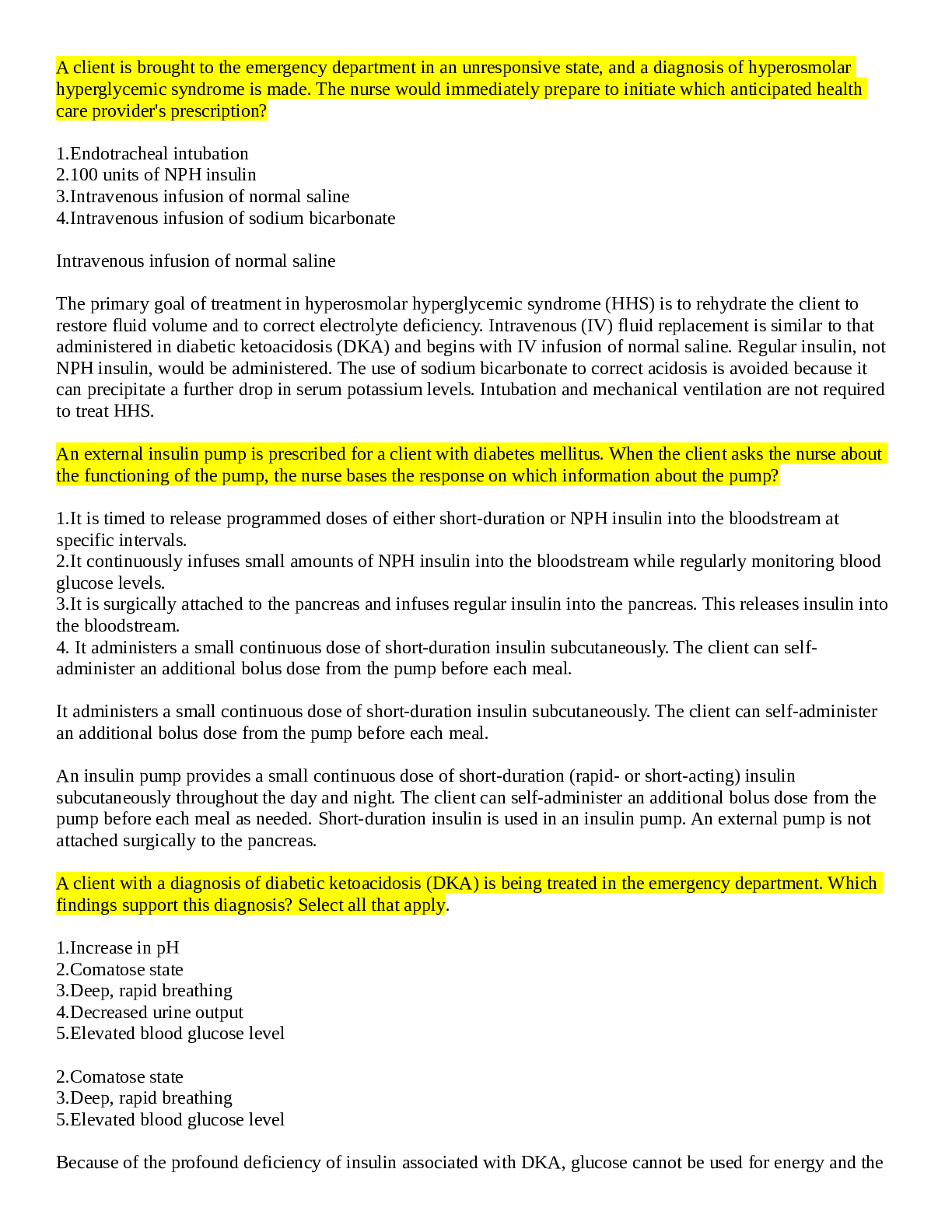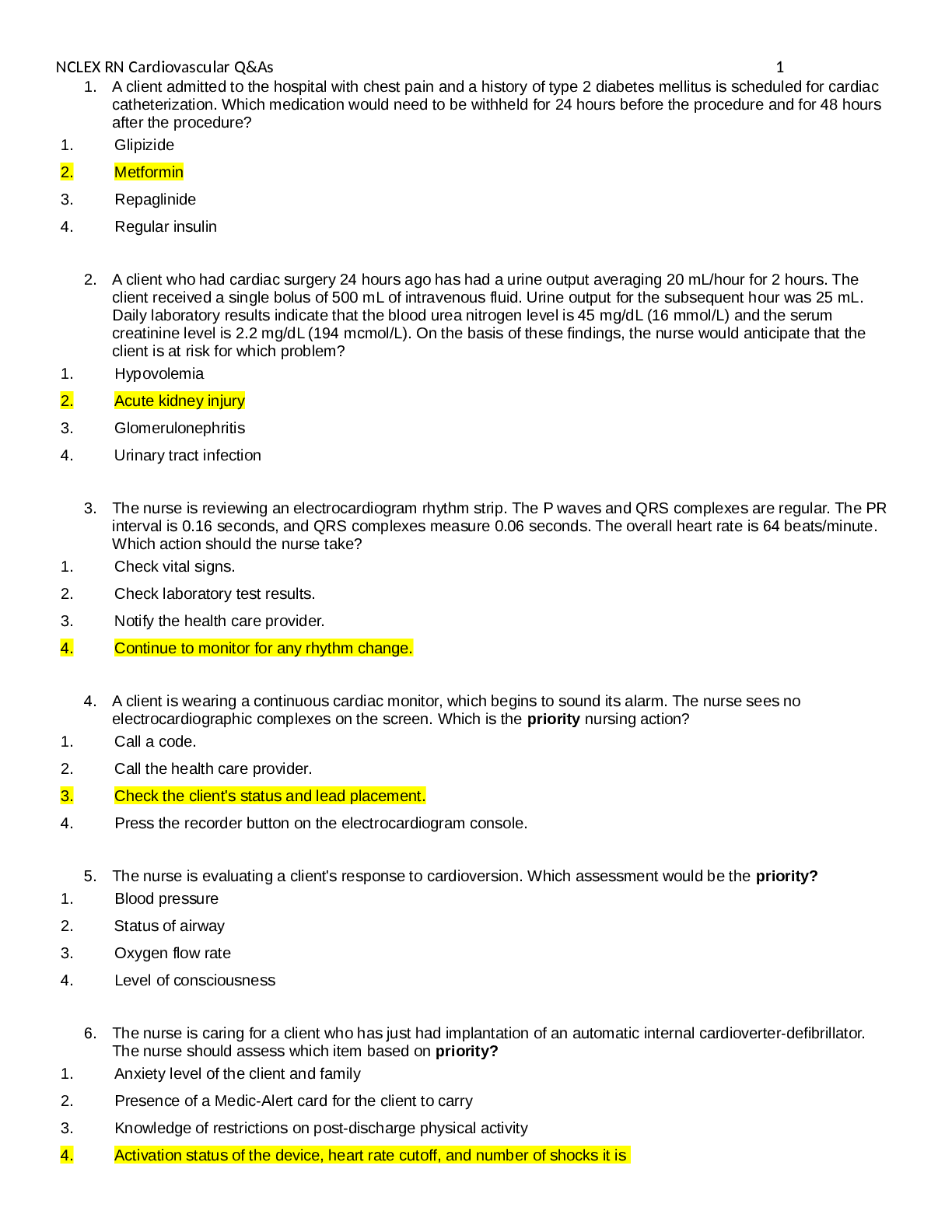NCLEX-PN Review Questions and answers, 100% proven pass rate, Graded A+
Document Content and Description Below
NCLEX-PN Review Questions and answers, 100% proven pass rate, Graded A+ The nurse is taking the health history of a patient being treated for Emphysema and Chronic Bronchitis. After being told th... e patient has been smoking cigarettes for 30 years, the nurse expects to note which assessment finding? 1. Increase in Forced Vital Capacity (FVC) 2. A narrowed chest cavity 3. Clubbed fingers 4. An increased risk of cardiac failure - ✔✔3. Clubbed fingers - CORRECT Clubbed fingers are a sign of a long-term, or chronic, decrease in oxygen levels. The nurse is taking the health history of a 70-year-old patient being treated for a Duodenal Ulcer. After being told the patient is complaining of epigastric pain, the nurse expects to note which assessment finding? 1. Melena 2. Nausea 3. Hernia 4. Hyperthermia - ✔✔1. Melena - CORRECT Melena is the finding that there are traces of blood in the stool which presents as black, tarry feces. This is a common manifestation of Duodenal Ulcers, since the Duodenum is further down the gastric anatomy. A nurse is providing discharge teaching for a patient with severe Gastroesophogeal Reflux Disease. Which of these statements by the patient indicates a need for more teaching? 1. "I'm going to limit my meals to 2-3 per day to reduce acid secretion." 2. "I'm going to make sure to remain upright after meals and elevate my head when I sleep" 3. "I won't be drinking tea or coffee or eating chocolate any more." 4. "I'm going to start trying to lose some weight." - ✔✔1. "I'm going to limit my meals to 2-3 per day to reduce acid secretion." CORRECT - Large meals increase the volume and pressure in the stomach and delay gastric emptying. It's recommended instead to eat 4-6 small meals a day. The nurse in the Emergency Room is treating a patient suspected to have a Peptic Ulcer. On assessing lab results, the nurse finds that the patient's blood pressure is 95/60, pulse is 110 beats per minute, and the patient reports epigastric pain. What is the PRIORITY intervention? 1. Start a large-bore IV in the patient's arm 2. Ask the patient for a stool sample 3. Prepare to insert an NG Tube 4. Administer intramuscular morphine sulphate as ordered - ✔✔1. Start a large-bore IV in the patient's arm CORRECT - The nurse should suspect that the patient is haemorrhaging and will need need a fluid replacement therapy, which requires a large bore IV. A female patient with atrial fibrillation has the following lab results: Hemoglobin of 11 g/dl, a platelet count of 150,000, an INR of 2.5, and potassium of 2.7 mEq/L. Which result is critical and should be reported to the physician immediately? 1. Hemoglobin 11 g/dl 2. Platelet of 150,000 3. INR of 2.5 4. Potassium of 2.7 mEq/L - ✔✔4. Potassium of 2.7 mEq/L CORRECT - A potassium imbalance for a patient with a history of dysrhythmia can be life-threatening and can lead to cardiac distress. While receiving normal saline infusions to treat a GI bleed, the nurse notes that the patient's lower legs have become edematous and auscultates crackles in the lungs. What should the nurse do first? 1. Stop the saline infusion immediately 2. Notify Physician 3. Elevate the patient's legs 4. Continue the infusion, since these are normal findings - ✔✔1. Stop the saline infusion immediately CORRECT - the patient has a fluid volume overload as a result of overly rapid fluid replacement. The nurse should stop the infusion and notify the physician. The nurse is working in a support group for clients with HIV. Which point is most important for the nurse to stress? 1. They must inform household members of their condition 2. They must take their medications exactly as prescribed 3. They must abstain from substance use 4. They must avoid large crowds - ✔✔2. They must take their medications exactly as prescribed CORRECT - Antiretrovirals must be taken exactly as prescribed to prevent drug-resistant strains. Even missed doses can reduce the effectiveness of future treatment. A nurse finds a 30-year-old woman experiencing anaphylaxis from a bee sting. Emergency personnel have been called. The nurse notes the woman is breathing but short of breath. Which of the following interventions should the nurse do first? 1. Initiate cardiopulmonary resuscitation 2. Check for a pulse 3. Ask the woman if she carries an emergency medical kit 4. Stay with the woman until help comes - ✔✔3. Ask the woman if she carries an emergency medical kit CORRECT - Many patients who have a known history of anaphylaxis carry epi-pens in their pockets or belongings. This is the best way to stop a hypersensitivity reaction before it becomes life-threatening. A man is prescribed lithium to treat bipolar disorder. The nurse is most concerned about lithium toxicity when he notices which of these assessment findings? 1. The patient states he had a manic episode a week ago 2. The patient states he has been having diarrhea every day 3. The patient has a rashy pruritis on his arms and legs 4. The patient presents as severely depressed 5. The patient's lithium level is 1.3 mcg/L - ✔✔2. The patient states he has been having diarrhea every day Correct - Persistent diarrhea can lead to dehydration, which can increase the risk of lithium toxicity. A 65 year old man is prescribed Flomax (Tamsulosin) for Benign Prostatic Hyperplasia. The patient lives in an upstairs apartment. The nurse is most concerned about which side effect of Flomax? 1. Hypotension 2. Tachycardia 3. Back Pain 4. Difficulty Urinating - ✔✔1. Hypotension Correct - Hypotension can lead to dizziness and a risk for injury to the patient. A man is receiving heparin subcutaneously. The patient has dementia and lives at home with a part-time caretaker. The nurse is most concerned about which side effect of heparin? 1. Back Pain 2. Fever and Chills 3. Risk for Bleeding 4. Dizziness - ✔✔3. Risk for Bleeding Correct - A confused patient is at risk for injuring themselves and at risk for hemorrhage should an injury occur A female patient is prescribed metformin for glucose control. The patient is on NPO status pending a diagnostic test. The nurse is most concerned about which side effect of metformin? 1. Diarrhea and Vomiting 2. Dizziness and Drowsiness 3. Metallic taste 4. Hypoglycemia - ✔✔4. Hypoglycemia Correct - The patient is at risk because she is on NPO status and continuing to take an anti-glycemic drug. The nurse is reviewing the lab results of a patient taking lithium for schizoaffective disorder. The lab results show that the blood lithium value is 1.7 mcg/L. What would the nurse take as the priority action? 1. Induce vomiting 2. Hold the next dose of Lithium 3. Administer an anti-emetic 4. Give the next dose of Lithium - ✔✔2. Hold the next dose of Lithium Correct - Lithium's therapeutic range is 0.5-1.5mcg/L, and begins toxicity at 1.5mcg/L A patient asks the nurse why they must have a heparin injection. What is the nurse's best response? 1. "Heparin will dissolve clots that you have." 2. "Heparin will reduce the platelets that make your blood clot" 3. "Heparin will work better than warfarin." 4. "Heparin will prevent new clots from developing." - ✔✔4. "Heparin will prevent new clots from developing." Correct -This is a correct statement. The nurse is reviewing the lab results of a patient who has presented in the Emergency Room. The lab results show that the troponin T value is at 5.3 ng/mL. Which of these interventions, if not completed already, would take priority over the others? 1. Put the patient in a 90 degree position 2. Check whether the patient is taking diuretics 3. Obtain and attach defibrillator leads 4. Check the patient's last ejection fraction - ✔✔3. Obtain and attach defibrillator leads Correct - This patient is undergoing an emergency cardiac event. Normal Troponin T levels are less than 0.2 ng/mL. Ventricular Fibrillation is the cause of death in most cases of deaths due to sudden cardiac arrest. Defibrillation is the most important action to take to prevent death. A nurse is caring for a patient undergoing a stress test on a treadmill. The patient turns to talk to the nurse. Which of these statements would require the most immediate intervention? 1. "I'm feeling extremely thirsty. I'm going to get some water after this." 2. "I can feel my heart racing." 3. "My shoulder and arm is hurting." 4. "My blood pressure reading is 158/80" - ✔✔3. "My shoulder and arm is hurting." Correct - Unilateral arm and shoulder pain is one of the classic symptoms of myocardial ischemia. The stress test should be halted. The nurse is reviewing the lab results of a patient who has presented in the Emergency Room. The lab results show that the BNP (B-type Natriuretic Peptide) value is a 615 pg/ml. What would the nurse take as the priority action? 1. Call a cardiac code and implement emergency measures 2. Check the patient's oxygen saturation 3. Inform the physician that the patient has Congestive Heart Failure Encourage the patient to limit activity - ✔✔2. Check the patient's oxygen saturation Correct - An elevated BNP indicates that there is decreased cardiac output. A priority intervention would be to ensure proper oxygenation after an assessment. A nurse is caring for a patient after a coronary angiogram. Which of these actions taken by the nursing assistant would most require the nurse's immediate intervention? 1. The nursing assistant fills the patient's pitcher with ice cold drinking water 2. The nursing assistant elevates the head of the bed to 60 degrees for a meal 3. The nursing assistant refills the ice pack laying on the insertion site 4. The nursing assistant places an extra pillow under the patient's head on request - ✔✔2. The nursing assistant elevates the head of the bed to 60 degrees for a meal Correct - For 3-6 hours after a coronary angiogram (depending on the insertion site), the patient should have their bed no higher than 30 degrees and be on bedrest. A man is has been taking lisinopril for CHF. The patient is seen in the emergency room for persistent diarrhea. The nurse is concerned about which side effect of lisinopril? 1. Vertigo 2. Hypotension 3. Palpitations 4. Nagging, dry cough - ✔✔2. Hypotension Correct - The patient is particularly at risk for hypotension due to possible dehydration from fluid loss. The nurse is taking the health history of a patient being treated for sickle cell disease. After being told the patient has severe generalized pain, the nurse expects to note which assessment finding? 1. Severe and persistent diarrhea 2. Intense pain in the toe 3. Yellow-tinged sclera 4. Headache - ✔✔3. Yellow-tinged sclera Correct - Jaundice is a common clinical finding of sickle cell disease, caused by bilirubin released from damaged or destroyed RBCs A client with Multiple Sclerosis reports a constant, burning, tingling pain in the shoulders. The nurse anticipates that the physician will order which medication for this type of pain? 1. alprazolam (Xanax) 2. Corticosteroid injection 3. gabapentin (Neurontin) 4. hydrocodone/acetaminophen (Norco) - ✔✔3. gabapentin (Neurontin) Correct - Anticonvulsants like gabapentin are often the first line of treatment for nerve pain Which of these clients is likely to receive sublingual morphine? 1. A 75-year-old woman in a hospice program 2. A 40-year-old man who just had throat surgery 3. A 20-year-old woman with trigeminal neuralgia 4. A 60-year-old man who has a painful incision - ✔✔1. A 75-year-old woman in a hospice program Correct - Sublingual morphine is often used in hospice because the patients are unable to swallow, and intravenous access can be painful and not conducive to palliative care. In educating clients on ways to manage pain, which topic can be appropriately delegated to a LPN/LVN who will continue under supervision? 1. Acupuncture 2. Guided Imagery 3. Alternating Rest/Activity 4. Over the counter medications - ✔✔3. Alternating Rest/Activity Correct - This is within the nursing scope of practice and within the training and education provided to all nurses. It is safe to use and a standard treatment. The nurse assesses a patient suspected of having an asthma attack. Which of the following is a common clinical manifestation of this condition? 1. Audible crackles and orthopnea 2. An audible wheeze and use of accessory muscles 3. Audible crackles and use of accessory muscles 4. Audible wheeze and orthopnea - ✔✔2. An audible wheeze and use of accessory muscles Correct - Both of these are associated with asthma. The nurse assesses a patient suspected of having meningitis. Which of the following is a common clinical manifestation of this condition? 1. A high WBC count and decreased level of consciousness 2. A high WBC count and manic activity 3. A low WBC count and manic activity 4. A low WBC count and decreased level of consciousness - ✔✔1. A high WBC count and decreased level of consciousness Correct - Meningitis is most often cause by an infectious organism, increasing the WBC count. One defining feature is an increased Intracranial Pressure (ICP) which presents as a decreased level of consciousness. consciousness. A patient is being treated in the Neurology Unit for Meningitis. Which of these is a priority assessment for the nurse to make? 1. Assess the patient for nuchal rigidity 2. Determine the patient's past exposure to infectious organisms 3. Check the patient's WBC lab values 4. Monitor for increased lethargy and drowsiness - ✔✔4. Monitor for increased lethargy and drowsiness Correct - Lethargy and drowsiness indicate a decreased level of consciousness, which is the cardinal sign of increased ICP (Intracranial Pressure), which can be life-threatening. The nurse is caring for clients in the pediatric unit. A 6-year patient is admitted who has 2nd and 3rd degree burns on his arms. The nurse should assign the new patient to which of the following roommates? 1. A 4-year old with sickle-cell disease 2. A 12-year old with chickenpox 3. A 6-year old undergoing chemotherapy 4. A 7-year old with a high temperature - ✔✔1. A 4-year old with sickle-cell disease Correct - The nurse should be concerned about the burn patient's vulnerability to infection. Sickle cell disease is not a communicable disease. A patient with Meningitis is being treated with Vancomycin intravenously 3 times per day. The nurse notes that the urine output during the last 8 hours was 200mL. What is the nurse's priority action? 1. Check the patient's last BUN 2. Ask the patient to increase their fluid intake 3. Ask the physician to order a diuretic 4. Notify the physician of this finding - ✔✔4. Notify the physician of this finding Correct - Vancomycin is a nephrotoxic drug and can cause impaired renal perfusion, which would cause a decreased urine output. This is a serious adverse effect and should be reported to the physician. A patient is being admitted to the ICU with a severe case of encephalitis. Which of these drugs would the nurse not be expect to be prescribed for this condition? 1. Acyclovir (Zovirax) 2. Mannitol (Osmitrol) 3. Lactated Ringer's 4. Phenytoin (Dilantin) - ✔✔3. Lactated Ringer's Correct - Lactated Ringer's solution is often used in fluid replacement therapy, which is not warranted if a patient is at risk for high ICP. . The nurse is treating a patient who has Parkinson's Disease. Which of these practices would not be included in the care plan? 1. Decrease the calorie content of daily meals to avoid weight gain 2. Allow the patient extra time to respond to questions and do ADLs 3. Use thickened liquids and a soft diet 4. Encourage the patient to hold the spoon when eating - ✔✔1. Decrease the calorie content of daily meals to avoid weight gain Correct - Calorie content should be increased for patients with Parkinson's Disease because of dysphagia (difficulty swallowing), as well as calories burned due to muscle rigidity. A 45-year old woman is prescribed ropinirole (Requip) for Parkinson's Disease. The patient is living at home with her daughter. The nurse is most concerned about which side effect of ropinirole? 1. Slurred speech 2. Sudden dizziness 3. Masklike facial expression 4. Stooped Posture - ✔✔2. Sudden dizziness Correct - Dizziness and orthostatic hypotension are serious adverse effects of this drug that can lead to an increased risk of falls. Ropinirole's drug class is a dopamine agonist, which mimic dopamine in the brain (PD is characterized by a lack of dopamine). The nurse is taking the health history of a patient being treated for Parkinson's Disease. After being told the patient has classic symptoms of Parkinson's, the nurse expects to note which assessment finding? 1. Tremors 2. Low Urine Output 3. Exaggerated arm movements 4. Risk for Falls - ✔✔1. Tremors Correct - Tremors is one of four cardinal signs of PD: the other three are rigidity, bradykinesia (slow movements), and postural instability A nurse enters a patient's room and finds them unconscious with a rhythmic jerking of all four extremities. The patient is foaming heavily at the mouth. The patient was on seizure precautions and the bedrails are up and padded. What is the nurse's priority action? 1. Administer Lorazepam (Ativan) 2. Turn the patient to his/her side 3. Call the physician 4. Suction the patient - ✔✔2. Turn the patient to his/her side Correct - Turning the patient to the side will keep the airway open, which is the first priority suction catheter into a patient's mouth is a last resort. A nurse is giving a discharge education to a patient who has been diagnosed with epilepsy. Which of these teachings would she stress the most? 1. Avoid doing alcohol and drugs 2. Follow up with the neurologist [Show More]
Last updated: 1 year ago
Preview 1 out of 28 pages
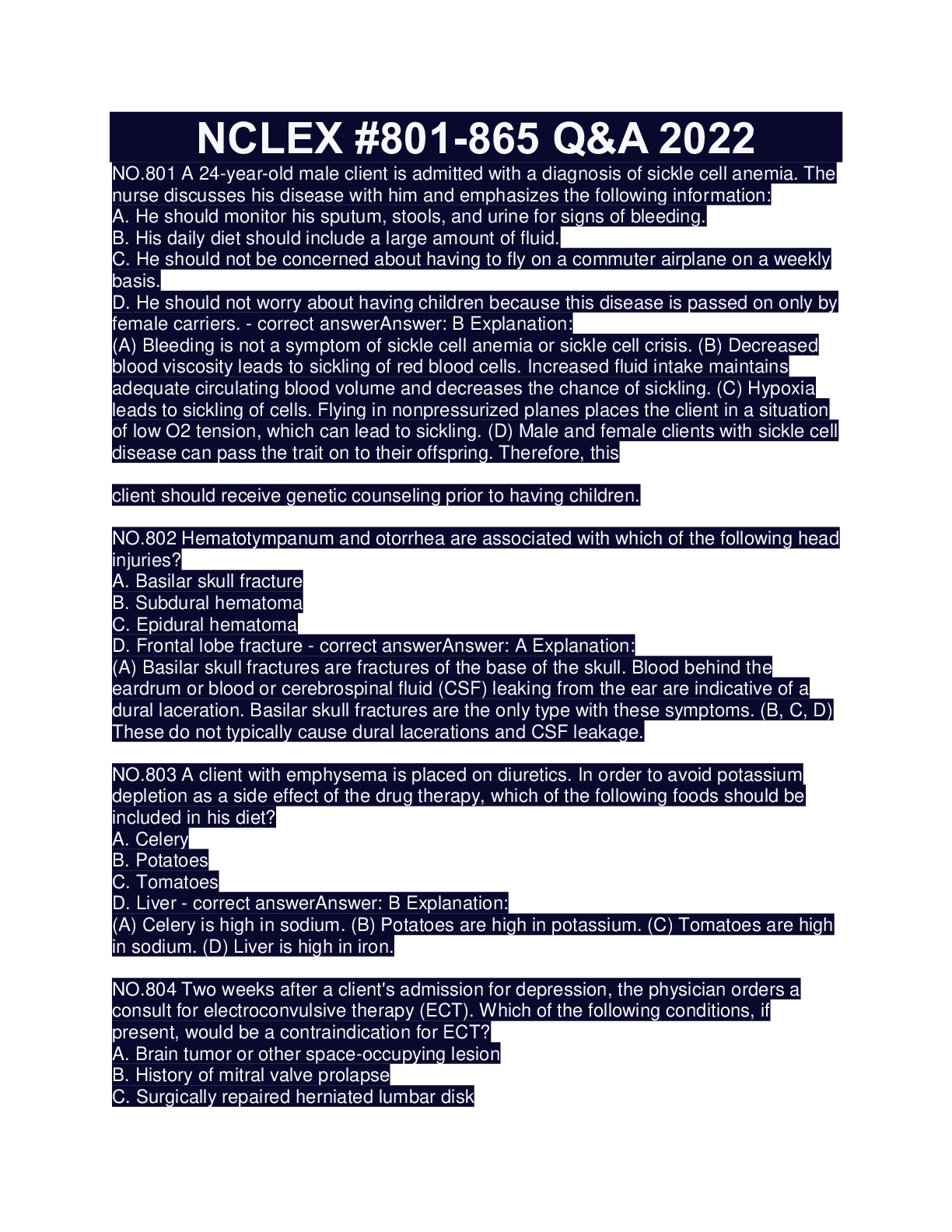
Buy this document to get the full access instantly
Instant Download Access after purchase
Add to cartInstant download
We Accept:

Reviews( 0 )
$9.00
Document information
Connected school, study & course
About the document
Uploaded On
Aug 26, 2022
Number of pages
28
Written in
Additional information
This document has been written for:
Uploaded
Aug 26, 2022
Downloads
0
Views
71

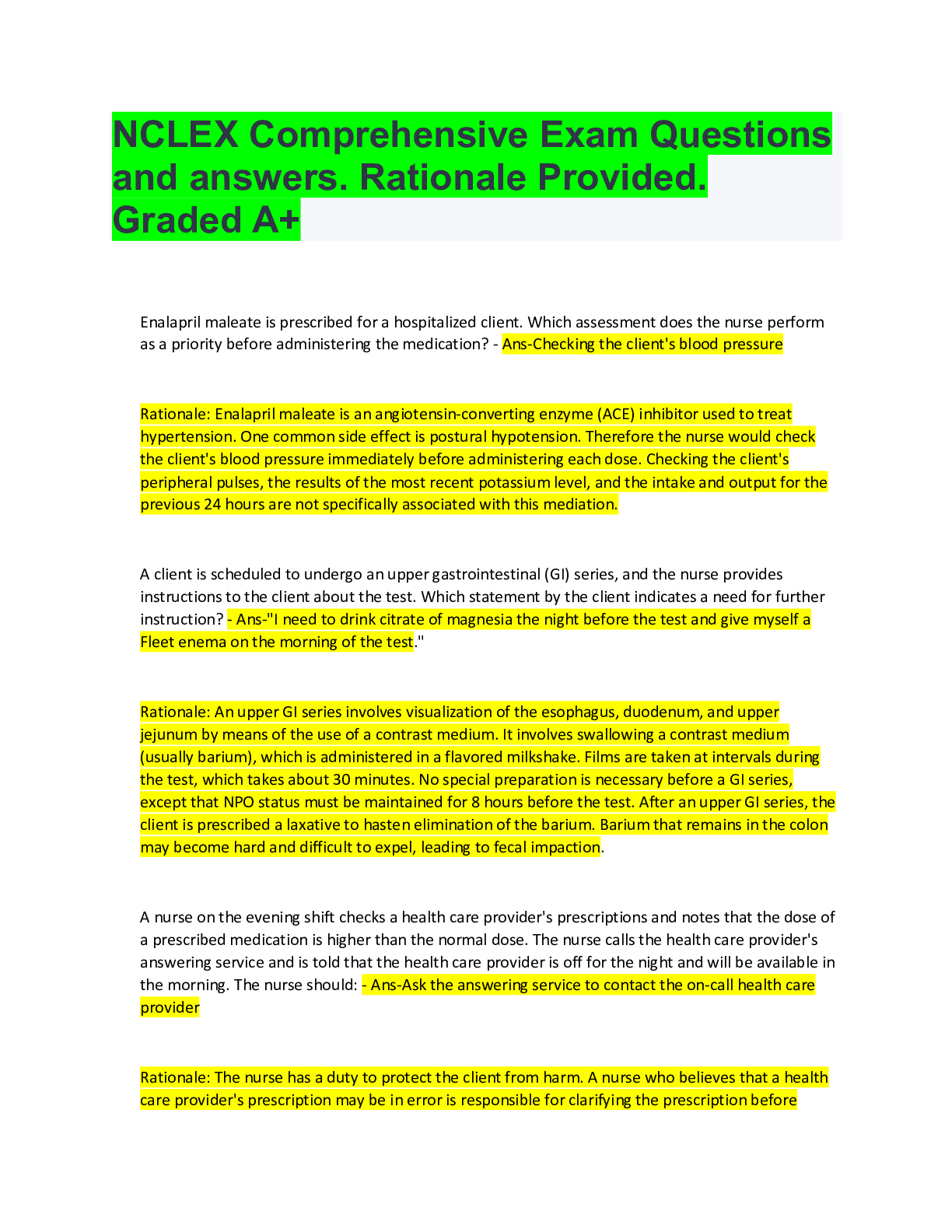



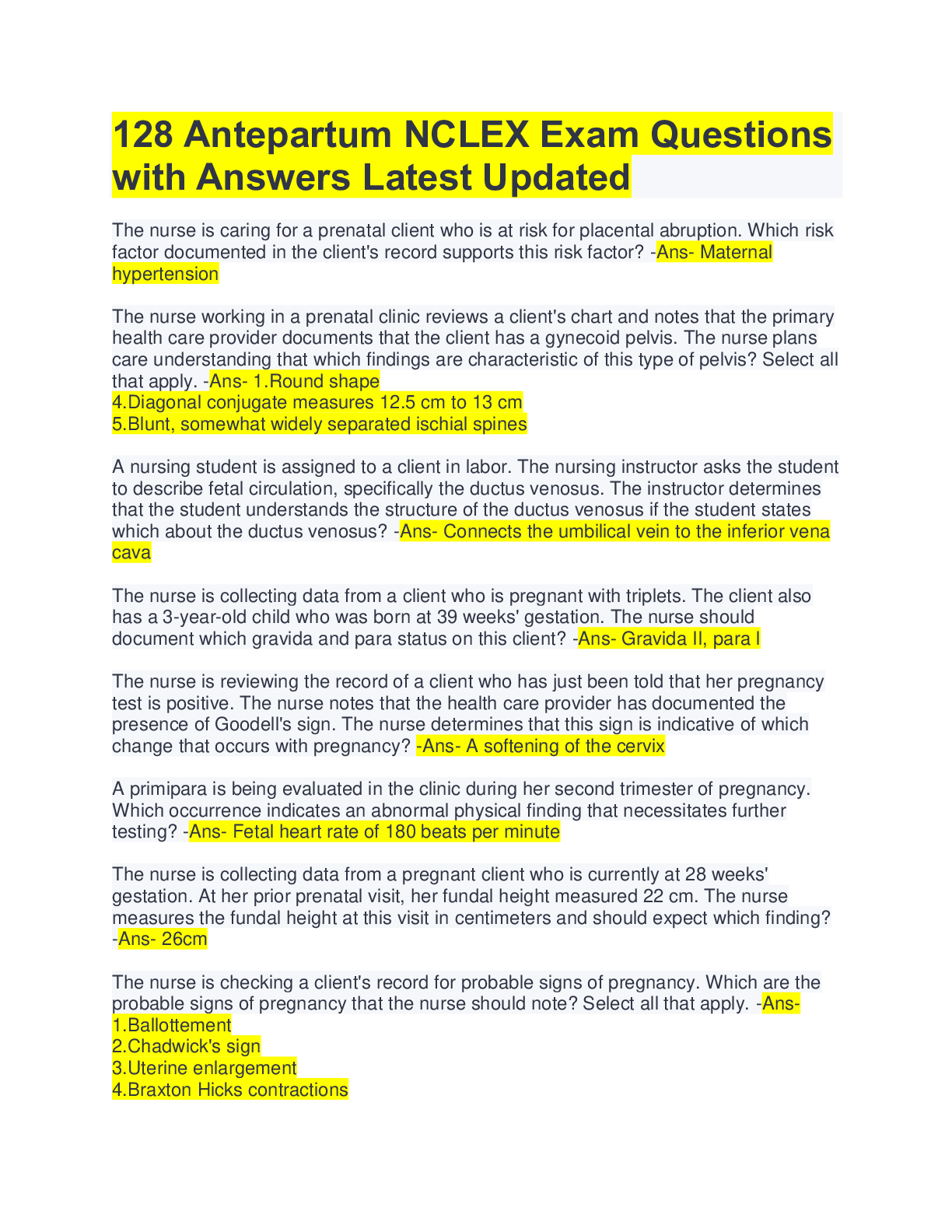
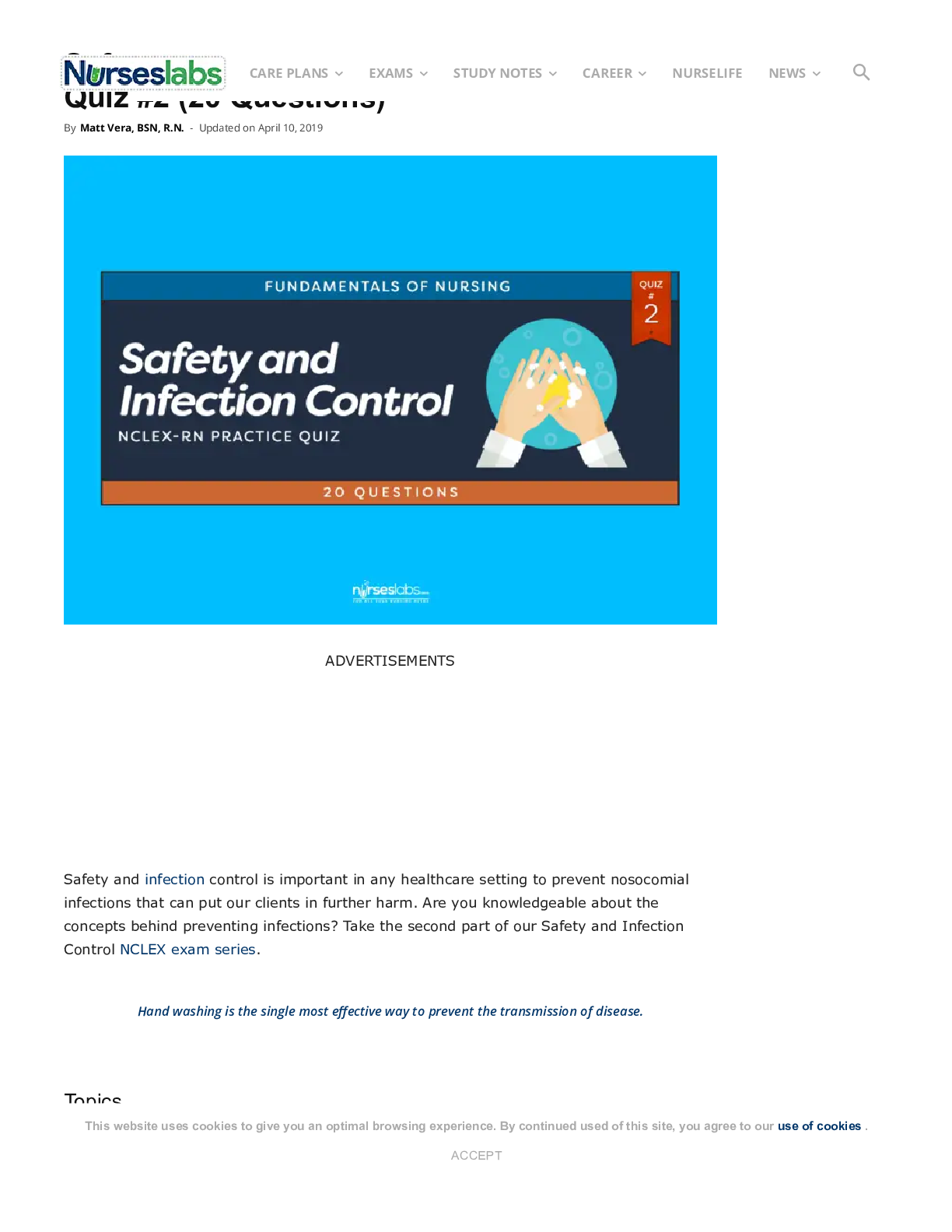

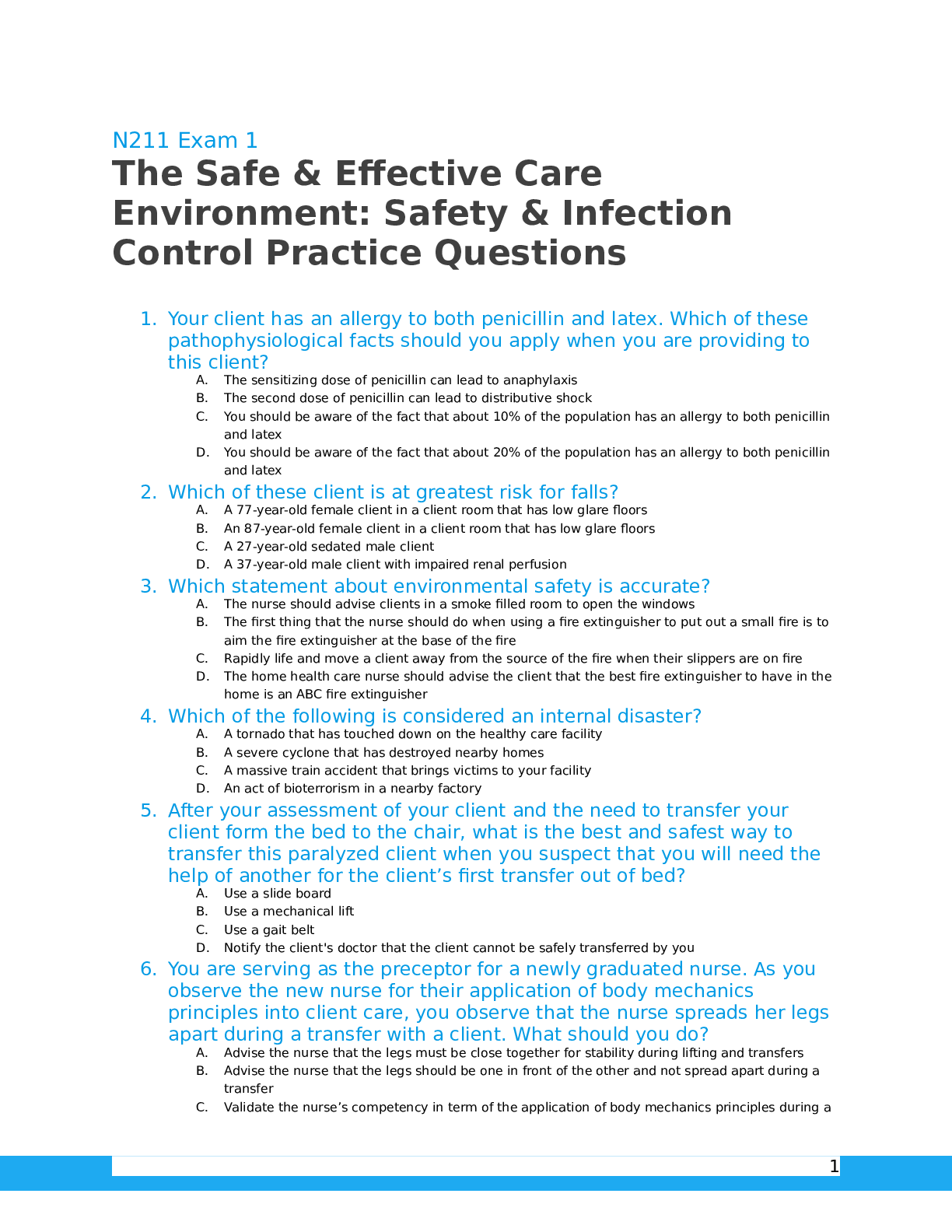
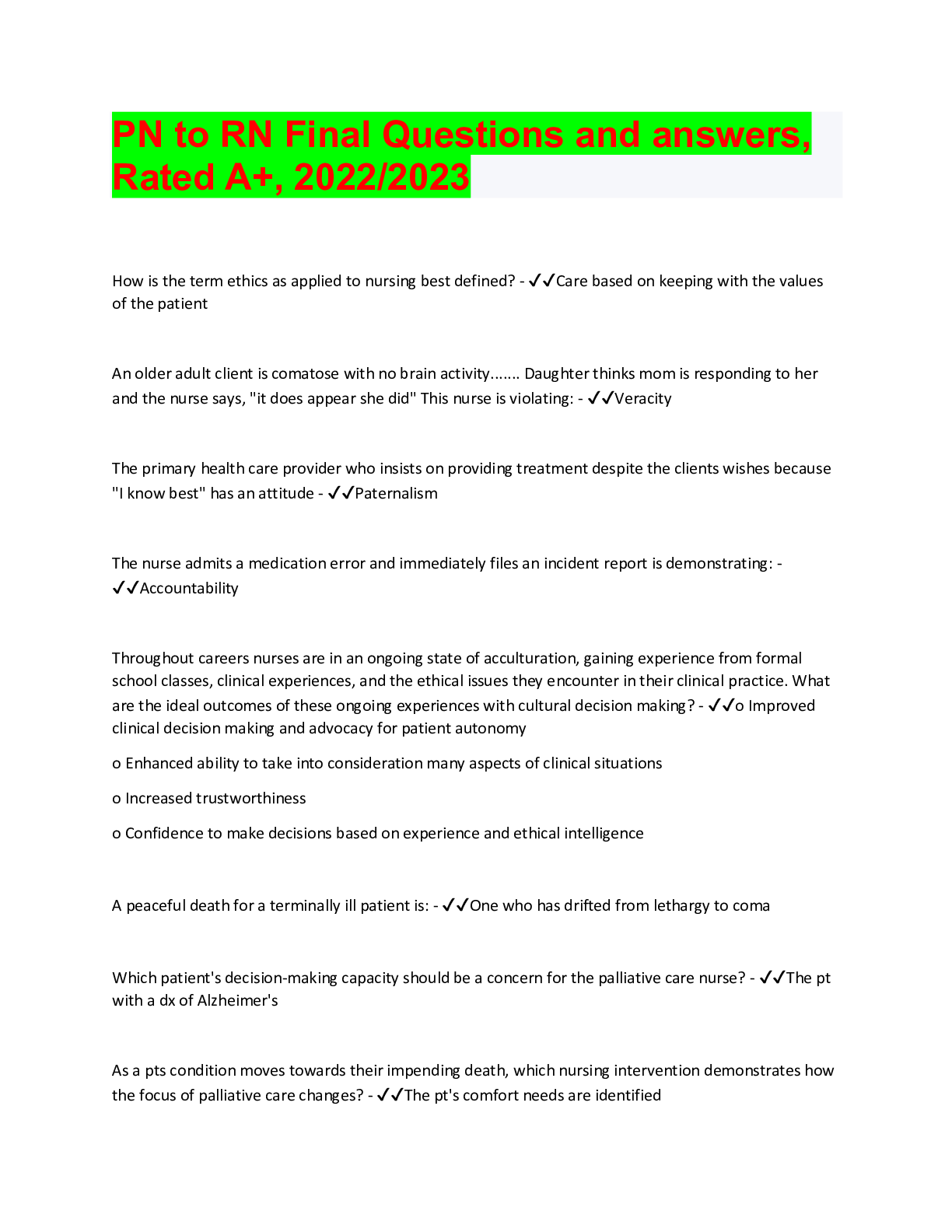
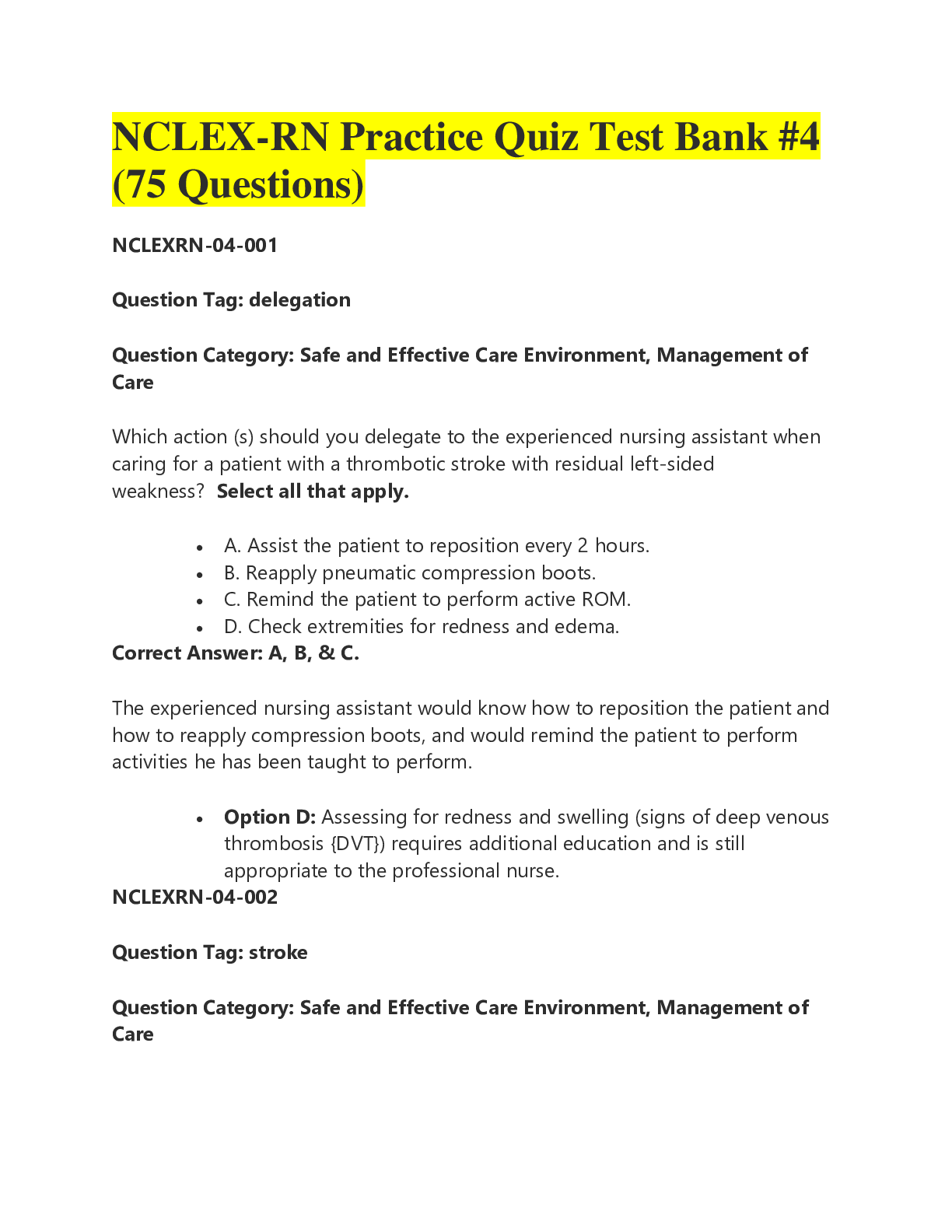


.png)
